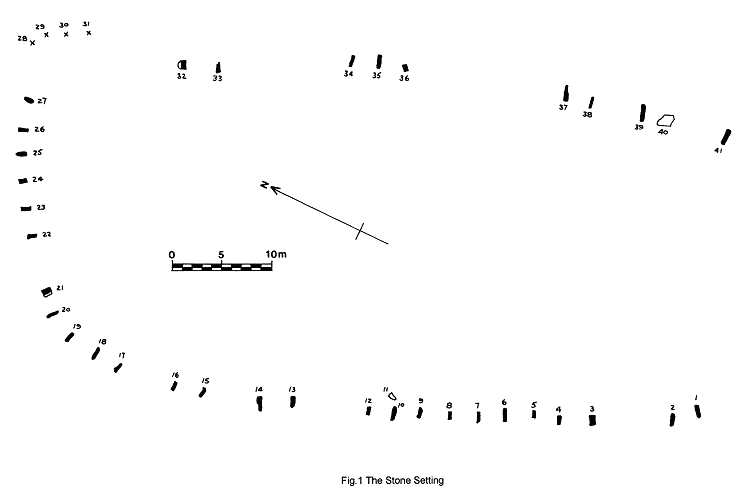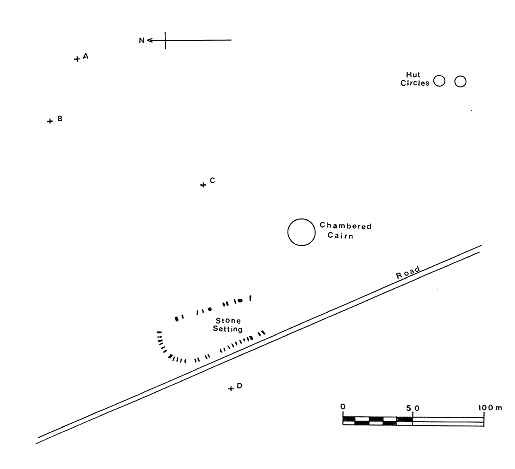
| N E W S F E E D S >>> |
|
Caithness Field Club Bulletin |
|
Achavanich - A Re-assessment
Location of the Horseshoe Setting The names themselves are of some interest in that the first two are Gaelic in origin and the latter is Old Norse. According to Beaton (1909, 331) Achavanich seems to be the Gaelic Ach a' mhannaich, the Monk's Field. Achkinloch is The field at the head of the loch and Stemster derives from the Old Norse stein meaning stone with the familiar Caithness place name ending -ster indicating a homestead. Of the three names Stemster is the least used so as not to confuse it with the same name elsewhere in the county. The site, at ND 1880 4178, is close to the road on the south side of Loch Stemster and the stones are set in the form of an irregular truncated oval, or horseshoe, and unusually pointing in towards the centre of the setting. Its axis lies NW-SE and it is open at the SE end where there is no evidence on the surface that it was ever fully enclosed. The two axes are approximately 69m and 31m; the latter widening towards the NW end. The setting is unusual in three particular aspects; 1. The stones point inwards. This feature, although uncommon, is however found to occur at the elliptical setting of Cnoc an Liath-Bhaid at Braegrudie, Strath Brora (NC 728 102) and at the ruinous setting of Clach an Righ, Dalharrold (NC 679 390), both in Sutherland; and also at Broubster (ND 047 608) in Caithness. 2. Whilst many stone settings conform to a geometrical shape of circular arcs that does not appear to be the case here, as the outline is somewhat irregular. 3. The shape is unusual in being a
horseshoe and open at one end. There is one other example of this in
Caithness and that is at Broubster (ND 047 608). Other examples are the
trilithon horseshoe at Stonehenge and the horseshoe setting at Er-Lannic,
Morbihan, Brittany which is now submerged by the sea at high water (Burl
1995,256). The first recorded survey of the site was made in 1871 by Sir Henry Dryden and R J Shearer. Later surveys were carried out by the author and the late Robert Gunn in 1974 and by Professor A Thom in 1981 (Thom, Thom and Burl 1990). All three surveys show exactly the same number of upright stones on the site. The plan shown in Fig.1 is based upon the survey of the author. Early descriptions of the stones 4: &c. Few of the stones are now fallen. Near the temple there is a ruin, where the Arch-Druid, it seems, resided. I find no such large Druid temples in the country; as for small ones, they are generally found in many places.' In 1886 Dr Anderson writes (Anderson,
1886); The Setting Today The ground falls away on each of the long sides if the setting with the road running close to the southwest. This road was described as 'new' on the 1871 plan. To the northwest the ground falls slowly whilst to the southeast there is a gradual rise. Between the stones on the southwest side there is evidence of banking and it extends as far as the northwest part of the setting. There is however no evidence of this on the opposite side in the northeast. Only excavation would determine the nature of this banking but does it suggest evidence the setting having been an enclosure? This might explain why the stones were set pointing inwards to support the banking. The grouping of the stones suggested by the Reverend Alexander Pope is difficult to understand since, apart from some grouping on the northeast side, which may be fortuitous, such groupings do not appear to exist. |


Fig 2 - The Surrounding Area
|
That the setting may have had
astronomical significance is mentioned by Dr Euan MacKie (MacKie 1975,
223). Certainly the hills including Morven and Maiden Pap to the southwest
and Ben Dorrery to the northwest would have provided ideal foresights for
either solar or lunar observation. 1. The Chambered Cairn 2. Hut Circles 3. Outlying Stones These outlying stones may have astronomical significance but this can only be determined by means of an accurate theodolite survey of possible alignments. There are good foresights to both the southwest in Morven and the adjoining peaks and also to the northwest in the hills of Dorrery and Beinn Freiceadain. All of these are quite distinctive on a clear day. The Present State of the Site The site has an atmosphere of neglect and can only give a very poor impression to tourists. Visitors are encouraged to visit the site in local publicity. The Caithness Explorer Holiday Guide for 2003 states 'At Achavanich, near Lybster. there is a striking collection of stones which is becoming increasingly accessible to the public..... Public access to Achavanich is being improved with the creation of a small car-parking area near the stones.' Presumably this refers to the additional lay-by recently made on the side of the road up against the stones. If we are to encourage visitors to visit our ancient monuments then something has to be done to present them to the public in a proper way. On one occasion during the summer of 2003 two bus-loads of people visited this site simultaneously almost blocking the road for the want of parking space despite the additional lay-by. What is required at this site is,
References |

The broken entrance gate to the Achavanich stone setting
Achavanich In the Caithness.org A - Z